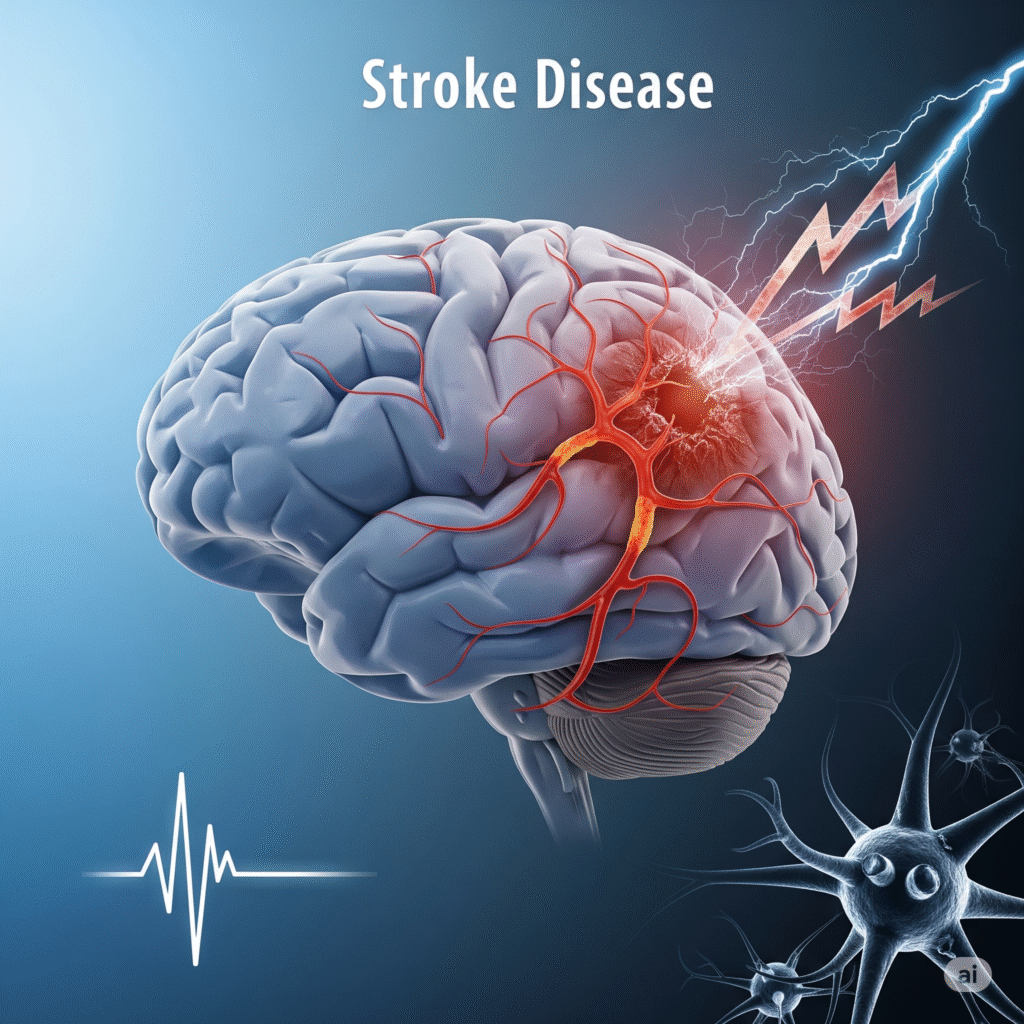Loss of consciousness or fainting in severe case.
Stroke
Introduction
A stroke is a sudden blockage of blood supply in one part of the brain, which prevents brain tissue from obtaining oxygen and nutrients. Within a few minutes, brain cells begin to die, making stroke a medical emergency that requires immediate attention. Depending on the affected brain region, it can cause paralysis, difficulty speaking difficulty, vision problems, loss of balance, or even death. Early diagnosis and treatment are important to reduce brain damage and improve recovery.

Types of Stroke
Ischemic stroke
It occurs when a blood clot blocks the brain artery, reduces the supply of oxygen. If treated early, it is normal and treatable with clot-busting drugs or mechanical removal.
hemorrhagic stroke
It occurs when a brain vessel breaks, causing bleeding and loss of pressure. Often associated with high blood pressure or arteriography; Immediate medical care is required.
Clinical features
Lorem ipsum dolor sit amet, consectetur adipiscing elit. Ut elit tellus, luctus nec ullamcorper mattis, pulvinar dapibus leo.
Investigations
Lorem ipsum dolor sit amet, consectetur adipiscing elit. Ut elit tellus, luctus nec ullamcorper mattis, pulvinar dapibus leo.
Causes of Stroke
- Hypertension damages brain vessels and breaking risk is increasing
- Atherosclerosis causes fatty deposits to block brain arteries
- Heart made blood clots and brain travel
- Uncontrolled diabetics damage blood vessels and increase clot risk
- Smoking narrows blood vessels and promotes clotting formation
- High cholesterol for plaque buildup in brain arteries
- Obesity stress on the cardiovascular system
- Excessive alcohol increases blood pressure and weak vessels
- Family history or genetic instinct
Clinical features of Stroke:
Sudden weakness or paralysis
Patients may experience sudden weakness, numbness or paralysis on one side of the body, usually affecting the face, arms or legs.
Speech and language problems
Difficulty may be caused by brain regions controlling brain regions, slide speech, or language.
Vision
Sudden blurred vision, dual vision, or complete loss of vision in one or both eyes can be based on the stroke space.
Coordination and loss of balance
Patients may cause difficulty, dizziness, or loss of balance and coordination, causing movement unstable or unsafe.
Sudden severe headache
A sudden, acute headache – often described as “worst” – indicates a hemorrhagic stroke and requires immediate treatment.
Symptoms associated with Stroke
- Sudden numbness or weakness in the face, arm, or leg, especially on one side of the body
- Confusion or trouble understanding spoken language
- Difficulty speaking or slurred speech
- Blurred, double, or sudden loss of vision in one or both eyes
- Dizziness or loss of balance while walking
- Sudden severe headache with no known cause
- Trouble swallowing or choking sensation
Investigations in Stroke:
- A CT scan quickly detects bleeding, clots or brain tissue damage. It helps differentiate between ischemic and hemorrhagic stroke, guiding the choice of emergency treatment.
The MRI provides wide brain images to identify stroke space and range. It is particularly useful for detecting small or early strokes remembered on CT scans.
This test uses sound waves to examine narrow or obstructions in carotid arteries. It helps identify atherosclerosis, which can cause ischemic stroke.
A dye is injected into blood vessels, and X-ray images are taken to see blood flow in the brain. It detects obstructions, arterirs or deformities.
Uses ultrasound to create heart images, checks for clotting, valve problems or abnormal structures. Heartmore clots can travel to the brain and cause stroke.
Clotting tests include blood sugar, cholesterol and infection markers. These help to identify the underlying conditions and risk factors that contribute to stroke development.
To detect irregular rhythm such as the atrial fibrillation to measure the electrical activity of the heart, which can cause a leading clot to the stroke.
When the bleeding is suspected, but does not appear on the scan. It detects blood in the cerebrospinal fluid, confirming cerebrospinal hemorrhage.
Evaluate blood flow to the arteries of the brain. It is useful for detecting narrowness, clotting or cramps after hemorrhagic stroke, especially in young patients.
